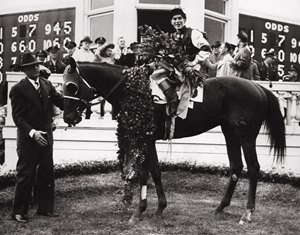Assault's Record Shows Change in Training Methods


After reporting that it was becoming increasingly difficult to gauge the talent of horses on the Triple Crown trail due to their ever-decreasing number of starts as 3-year-olds, the BloodHorse was contacted by Bill Hirsch, whose pedigree includes being the grandson of Hall of Fame trainer Max Hirsch and the son of trainer Buddy Hirsch.
Max Hirsch trained for King Ranch, and won the 1946 Triple Crown with Assault and the 1950 Kentucky Derby with Middleground. Suffice to say, his training methods were quite different than those of today.
"If someone trained like that today, they'd lock him up," Bill Hirsch said. "I can't believe how under-trained and lightly raced these horses are now compared to 70 years ago."
Hirsch, who worked for his father and eventually took over training the King Ranch horses, admitted he was "old-fashioned," but longs for the days when trainers would send out their charges for a one-mile work a week before the Derby and then blow them out a day before the race. He sent along Assault's training schedule leading up to and carrying through the Triple Crown series:
- April 1 Shipped to Belmont Park
- April 5 Worked three furlongs in :37
- April 6 Worked six furlongs in 1:14
- April 9 Won season debut six-furlong Experimental Free Handicap in 1:12
- April 12 Worked four furlongs in :48 2/5
- April 14 Worked three furlongs in :35 1/5
- April 15 Worked one mile in 1:43 4/5
- April 18 Worked one mile in 1:41 2/5
- April 20 Won 1 1/16-mile Wood Memorial in 1:46 3/5
- April 23 Worked three furlongs in :39; shipped to Churchill Downs
- April 30 Finished fourth in one-mile Derby Trial over a muddy track
- May 3 Worked four furlongs in :48
- May 4 Won 1 1/4-mile Kentucky Derby by eight lengths in 2:05 3/5 (sloppy track)
- May 5 Walked
- May 6 Shipped to Pimlico
- May 8 Worked three furlongs in :40
- May 9 Worked one mile in 1:45
- May 11 Won 1 3/16-mile Preakness by a neck in 2:01 4/5
- May 12 Shipped to Belmont Park
- May 16 Worked four furlongs in :52
- May 18 Worked three furlongs in :40
- May 20 Worked four furlongs in :48
- May 22 Worked one mile in 1:43 3/5
- May 24 Worked three furlongs in :35
- May 25 Worked 1 1/4 miles in 2:05
- May 28 Worked four furlongs in :50
- May 29 Worked 1 1/2 miles in 2:32
- June 1 Won 1 1/2-mile Belmont Stakes by three lengths in 2:30 4/5
Assault (Bold Venture—Igual, by Equipoise) breezed up to a dozen times per month and raced an average of twice a month, sometimes three times. Note that in 1946 there were two weeks between the Wood Memorial and Kentucky Derby and one week between the Derby and the Preakness Stakes.
"All the top trainers conditioned their horses like that back then," said Hirsch. "The breezes ensured that Assault received race-specific conditioning allowing his body to remodel itself to withstand the pressures of racing. Plus the breezes developed his ability to recover from a race in a few days."
Assault's eight-length winning margin in the Derby equals the record for largest, tying Old Rosebud, Johnstown, and Whirlaway.
As recently as 40 years ago, Seattle Slew was blowing out three furlongs the day before his races, but we have rarely seen that kind of training since, and the trend clearly has moved toward less races as well, as Derby starters today make an average of 1 1/2 fewer starts as 3-year-olds before the Derby than 25 years ago.
